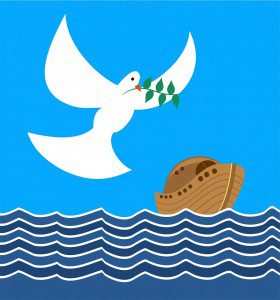Once upon a time, most of us were small children in a Sunday school classroom. If your children’s liturgy was typical, you probably made that craft: you know, the cut-out Noah’s Ark that you colour and then you make all kinds of little cut-out animals, ideally in pairs (though in practice that kind of depends on the attention span of the kid). If your Sunday school teacher was really ambitious, maybe you stuck some balls of cotton wool onto your sheep. You sang a song about humptedy back camels, chimpanzees and unicorns and presto! Biblical literacy.
Now, as grown adults we all realize that there was never a literal geological event in which the entire earth was flooded by 40 days of rain and all animal life on the planet was saved by a guy with a really big boat. Obviously, Noah did not stand up on a Syrian mountain, whistle, and somehow summon kangaroos from Australia, moose from Canada, polar bears from the Arctic and crab-eating macaques from Malaysia. The logistical problems involved are simply insurmountable, not to mention the fact that such a catastrophe would certainly have left a mark on the geological and fossil record.
Does this mean that the story is a lie? No. Intelligent Christians going back to the early Church have understood that many of the stories in the Bible are just that: stories. There is almost certainly some literal sense to the story of Noah and the flood (it’s certainly a common motif in near-Eastern mythologies), but whether it’s dealing with the experience of ancient peoples learning how to overcome annual inundations, or its describing a particular environmental catastrophe that happened somewhere in Mesopotamia, whether there was actually a huge boat whose remains can be found on the side of Mount Ararat, or whether the explanation is something else entirely is a question that will probably be providing scholars with heated argumentative merriment for many generations to come.
But the fact that it’s not a literal historical account, in the modern sense (the genre we think of as history was likely not even invented at the time when Genesis was composed – and certainly it didn’t exist when the oral histories from which Genesis was derived were developing.) It’s not recording literal fact any more than Jesus is telling a literally true story when He says that there was a master who praised his steward for defrauding him of debts owed (cf. Luke 16). These stories are meant to illuminate truth, but not to record literal fact.
My point here is not to dismiss Biblical literalism but rather to explore the relationship between different modes of approach to truth and to chart the ways in which we encounter truth as human beings.
In the case of Noah, we start off with an event that is lost to history. We don’t know what exactly the facts of the event were. We don’t know if Noah was an individual person or (as some scholars have suggested) a name representing a tribe or a people. We don’t even know at what point the story was written down, or by whom. All we know is that the story exists, and that at some point, probably by the 5th century BC, it came to have the narrative and literary structure that we’re all familiar with today.
So basically, a story concerning unknown events becomes a story about God’s providential care for His creation, His wrath against a previous generation, His establishment of a covenant with His people. Through centuries of interpretation these themes become part of a cultural, national heritage – an origin narrative that gives shape to the identity of the Jewish people. Then it’s taken up into the Christian canon, where the flood comes to symbolize baptism, the olive branch in the beak of the dove foreshadows the anointing by the Holy Spirit, the covenant becomes a promise of the mercy which is to come in the person of Jesus.
As theologians elaborate increasingly complex levels of meaning, which then fuel further discourse surrounding the text, at the same time there’s a contrary movement: a simplification. The full interpretive tradition is inaccessible to the common believer, and so there’s an impulse back towards the original story and the simplicity of its iconography.
At the end of the process, we end up with felt cut-outs, paper Noahs on popsicle sticks, Playmobil arks and improbable menageries.
My inner snob is inclined to poo-pooh this latter, rather kitschy manifestation – but in a certain sense it is the most profound. What it reveals, with stark primary colours and wide googly eyes, is possibly the single most important thing that we need to know about our attempts to reach the truth: they are games. Confronted with truth, we are all like children playing with cute little plastic animals.
This essential realization is not a realization about the nature of truth itself, but about the nature of our relationship with it. Unless we “become like little children, [we] will never enter the Kingdom of Heaven.” (Matt. 18:3) Part of this “becoming like children” is a realization of our own humility before truth – an acceptance of the fact that our greatest philosophical and theological accomplishments are, in the words of Thomas Aquinas, “straw.”
The acceptance of this reality leads towards a kind of intellectual humility, and it has a huge impact in terms of how we carry out philosophical and theological engagement. If I think of myself as being in possession of truth as such, I’m likely to behave like the child on the playground who is constantly bossing and bullying the other kids into playing the game according to their rules. But if I recognize that my ideas are basically toys, then it follows that I’m supposed to share them and that when I share them I have to be okay with the fact that other people may play with them differently than I would have.
It means that I have to be open to idea that it’s alright if I draw Noah’s eyes in brown, and the kid next to me draws them in blue – even if I’m the smart kid who knows that, statistically speaking, a man from the Middle East was much more likely to be brown-eyed. It means recognizing that the other person who is playing with me has just as much right to contribute to the game as I do. It means accepting that ultimately my attempts at philosophy will always be produced from the rational equivalent of paper mache and tempera paint.
It also means believing that this is okay. At the end of Sunday school, when every child brings their little ark up to show it to mommy and daddy, the parents aren’t upset that the ark is coloured in a variety of improbable colours, that there’s only one raccoon, and that the popsicle stick is jutting out from beneath Noah’s gown at an awkward angle. The child is proud of her work. The parent is happy with her efforts. And in a small, delightful way the soggy mess of glue and glitter proclaims the truth and gives glory to God.
Picture credit: pixabay













